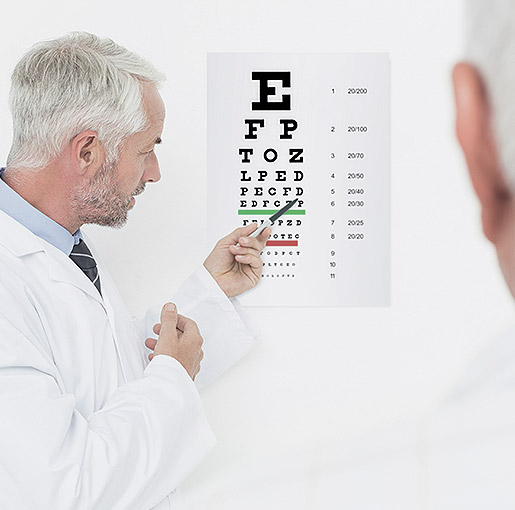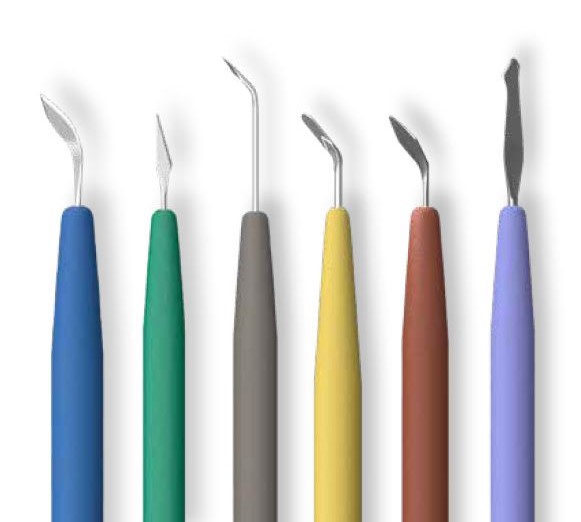What you should know about cataracts
Cataracts? Nothing to worry about!
Help with cataracts
You have been diagnosed with cataract. The treatment involves replacing the natural lens of the eye with an artificial lens, a so-called intraocular lens (IOL). This can significantly improve vision.
As a manufacturer of medical implants for eye surgery, we develop and produce these artificial intraocular lenses. Our goal is to offer your ophthalmologist the best possible treatment options to maintain your eyesight with a selection of high-quality premium products.
The following pages provide information on cataracts and a helpful overview of the various treatment options. You will also learn more about our state-of-the-art production technology to the highest quality standards for your maximum safety.
If you have further questions about your treatment, please contact your opthalmologist.
Overview of topics
Cataract diagnosis
What does it mean to have cataract?
The human eye contains a natural lens which, similar to a camera, is responsible for our ability to see a sharp image of our environment. This lens is usually crystal clear in young eyes. The clouding of the natural lenses of our eyes over time is a completely natural aging process and is called cataract.
The aging of the lens progresses slowly and is accompanied by a gradually deteriorating visual acuity.
The perception of the environment will appear as if through a cloudy frosted glass pane. Occasionally, it is accompanied by an increased sensitivity to glare.
Vision without cataract
Vision with cataract
In addition to the most frequent cause – namely ageing – clouding of the lens can also be congenital or caused by an injury to the eye or by medication.
In the case of extreme nearsightedness, farsightedness, or astigmatism, the ophthalmologist might advise to remove the natural eye lens before it becomes cloudy and replace it with an artificial lens of appropriate correction. This type of lens replacement is called “refractive lens surgery” or “clear lens extraction.”
How can cataracts be recognized?
Cataracts develop slowly. Initially, the patient does not notice them. Vision slowly degrades, colors fade, and reading becomes difficult. Light sources such as the headlights of oncoming vehicles when driving at night are increasingly perceived as disturbing.
An ophthalmologist can easily see whether sight problems are due to cataract by simply looking into the eyes, without causing any pain at all. Regular check-ups by an ophthalmologist help to early detect and treat sight-threatening problems. The ophthalmologist will talk to you individually about the right timing for your cataract surgery.
Cataract treatment
How are cataracts treated?
If lens opacity increases, surgery is the only treatment available to restore good vision. Currently, no alternative or drug therapies are available.
Cataract removal is one of the most common operations worldwide. Every year, about 800,000 procedures are performed in Germany alone.
During the procedure, usually an outpatient operation, the natural eye lens is removed and replaced by an artificial lens (also known as intraocular lens, or IOL for short). The short procedure is usually painless and causes very little discomfort for the patient.
How does the lens replacement work?
Local anesthesia is often sufficient for lens replacement. In order to insert the artificial lens and the necessary surgical instruments into the eye, a small incision is made. The incision usually closes up after the operation without the need for sutures. Once the natural eye lens (1) is crushed and removed (2), the artificial lens is inserted (3). IOLs made of soft, pliable material are the standard in current medical cataract treatment, as they enable gentle minimally invasive procedures. After implantation, the IOL unfolds in the eye on its own. The surgeon can easily and accurately align the IOL in the eye. Small elastic clamps, so-called haptics, securely fix the optically effective area in the eye (4). Normally, the patient can see clearly again shortly after the operation.
Benefits of treatment
What benefits can be achieved with this procedure?
By replacing your cloudy lens with an intraocular lens, your eyesight will usually be markedly better. As a foundation for successful treatment, your ophthalmologist must carry out a thorough examination.
Prevailing eye diseases, such as glaucoma or macular degeneration, can have an adverse effect on the outcome despite successful treatment of the cataract.
The ophthalmologist will determine the right intraocular lens for you, based on the results of the examination, your personal expectations and circumstances.
Individual care
Which individual treatment options are available for cataracts?
A range of implants with different properties are available to surgeons for the treatment of cataracts.
The standard treatment is the use of so-called monofocal lenses (“single power lenses”) made of high-quality material. They enable clear eyesight at the preferred distance (far or near).
Innovative premium intraocular lenses are equipped with special functions and can offer additional benefits over standard IOLs depending on individual needs and medical criteria.
Read on to learn more about the advantages and potential applications of different intraocular lenses (IOLs).
| Monofocal IOLs | the standard treatment for cataract. |
| IOLs with XL optic | optimal for patients with large pupils and for long-term reliable treatment |
| Aspheric IOLs | for more safety through eyesight with better contrast: e.g. when driving or in dim light conditions. |
| Trifocal IOLs | comfortable sight at all distances: near, intermediate, and far. |
| Toric IOLs | for distance vision without glasses with an existing astigmatism. |
| Toric multifocal IOLs | vision at all distances even with an existing astigmatism. |
| Yellow IOLs | with a blue light filter to protect your retina against high-energy “harmful” light. |
Premium implants
What is so special about IOLs made by HumanOptics?
HumanOptics Holding AG is one of the leading manufacturers of the highest quality intraocular lenses. Our goal is to restore the best possible vision to the human eye: quality and innovation for the benefit of patients.
| 100% Made in Germany | We, at HumanOptics, produce all our products in Germany, at our company headquarters in Erlangen and at our second production site in Sankt Augustin. From development through to production to the final product ready for dispatch, all stages of manufacturing are carried out in-house in accordance with the strictest standards laid down in our quality management procedures. |
| Cutting-edge technology for premium implants | For the production of our premium IOLs we use ultra-modern precision lathes enabling the creation of an optical surface with unrivaled precision. This advanced technology results in premium quality optical surfaces for brilliant, clear and sharp images. |
| Safety is our top priority | Quality assurance for our implants is paramount to us. We inspect every single lens multiple times so that we can prove that each patient is getting a perfect lens. With our quality management which is regularly audited in-house and by external experts, we guarantee the highest level of production safety. |
| HumanOptics – the reliable partner of your ophthalmologist | Since the development of the first intraocular lens in 1949, a lot has happened: gentle surgical procedures, the latest IOL technologies, and modern, safe manufacturing methods have steadily improved patient care. We have more than 35 years of experience in the development and production of intraocular lenses, and we set a global standard for innovation and safety. Using the most advanced technology, we work every day to provide your ophthalmologist with the best medical implants to enable optimal treatment for you. |
Place your trust in German quality workmanship and our long years of expertise!
This post is also available in: German
OUR
CUSTOMER SERVICE
YOUR
QUESTIONS
Our experts support you with your questions at any time.









